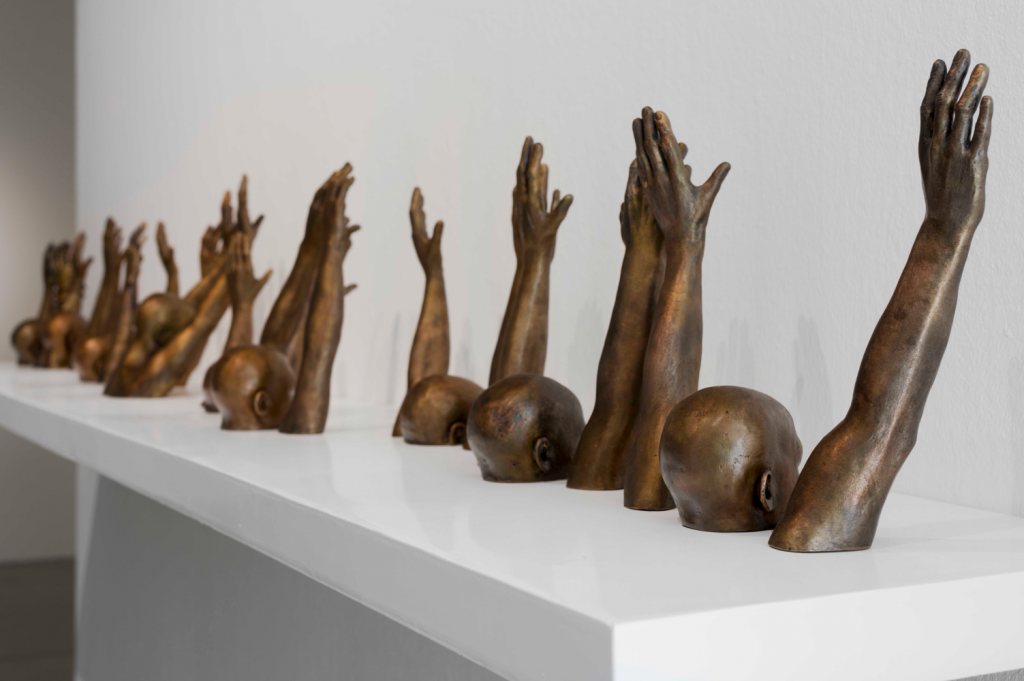
Hank Willis Thomas. Raise Up, 2014
Do #blacklivesmatter to the art world? Not when it really counts, writes an African American woman working in arts PR:
“It’s not like my colleagues don’t know how to talk about blackness in the arts. We talk about it all the time! We write press release upon press release about the importance of promoting artists of color so that their perspectives are included in conversations about race today. And when we’re successful, we pat ourselves on the back for a job well done — because of our work another black voice is featured, and audiences are educated, and we sleep easy knowing that we’ve made a difference. Today, though, there’s no conversation. No job well done. No sleeping easy. It’s a problem that I work in a profession that capitalizes on how cool it is to be black until it’s not cool to be black…”
- Some artists, however, have jumped into protests against the police killings of Eric Garner, Michael Brown, and Tamir Rice. “We need new Dylans. New Public Enemys. New Simones,” urged the Roots’s Questlove on Instagram. “I’m not saying every song gotta be ‘Fight The Power’ but in times like these we need to be more community minded. … Seriously just ONE or Two songs that change the course.” And sound artist Matana Roberts, musician Me’shell Ndegeocello, and poet Staceyann Chin offer a powerful call to action in a new release, Raise the Roof – Information, Class & Greed Besmirch Democracy: “My death must mean something more than a footnote in the media frenzy of our time.”
- “Does knowledge change when it is presented in different technological forms and cultural contexts? Through processes of experimentation, and by producing unconventional perspectives, can artists illuminate existing knowledge and meaning for a new generation? Can an artwork lead us to new modes of consciousness?” asks Recharge, Experimenta’s 6th International Biennial of Media Art, which surveys current forms of media practice.
- Artists Christoph Wachter and Mathias Jud have installed DIY antennae near Berlin’s “NSA’s Secret Spy Hub” so participants can send anonymous messages—from activist missives to pleas to surveillance operatives to become whistleblowers—to the NSA and GCHQ. Wachter and Jud also offer guided tours to discuss the project and let people experience the mesh network.
- Referencing Duchamp’s concept of “infrathin,” Paul Soulellis writes that “we participate in shifting the transformational value of the material each time the framing changes” by which we can never know our relationship to the primary source. From materializing digital files to streaming artworks to websites, artists’ web-to-print practice has evolved into “performing publishing”—the self-conscious “performance of an idea by distributing it to a networked audience.”
- “Verticality is an attempt to escape,” Louise Bourgeois once said. “Hanging and floating are states of ambivalence.” In a psychological show Suspensions, the late artist’s works render hysteria male through a series of sensual suspended sculptures.
- City council member Clay Yarborough has called for the defunding of Jacksonville MOCA over the display of an Angela Strassheim photo of a nude pregnant woman, dubbing it “pornographic.” It’s unlikely his call will ever be satisfied: Not only has the MOCA director spoke against “diminishing the exhibition,” but the city mayor Alvin Brown has also refused to force MOCA to bring the work down.
- “Nauman’s art bothered me. It was both psychologically and culturally threatening, and the very fact that it bothered me bothered me,” writes Peter Plagens in his new book—an uncommonly approachable take on artist Bruce Nauman.
- In an op-ed and a new set of intricate diagrams, artist William Powhida shines a light on the institutional structures that perpetuate the “endemic” economic imbalance in the art world, and suggests ways to fix them. Artists are, idealistically speaking, a working class aspiring to control some condition of their labor. “If we have any hope of changing the terms of capitalism (before it changes us irrevocably), we need to effect change throughout the entire art ecosystem,” he writes. “We need to encourage greater solidarity, in part by reaching out to artists who have access to levers of power in the vertical towers of selectivity like Art Basel Miami Beach…”
Follow Art News From Elsewhere on the Walker Art Center homepage or via @walkermag, the Walker’s editorial-focused Twitter feed.



